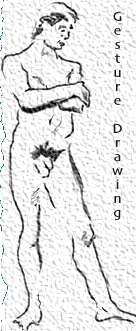 Primer |
Gesture DrawingGesture drawings are quick sketches that are based on careful observation. A good way to speed up your figure drawing is to break down the model into a number of simple lines that describe the pose. Look for areas of tension, that is, where the most activity is going on. It is also not necessary to do a complete outline of the form. You can sometimes represent an arm or leg with one line that describes one edge of the figure. This form of drawing encourages faster drawing as well as good observation. It is also a great way to catch a moment in time. Gesture for Constructing the Figure: There is a method for constructing the figure from gestural lines which are indicator of the general pose. It appears much like a stick figure, only without the stereotypical round head. Using this process, one should try to find the center of the figure and start with the instances of greatest tension or where the weight of the figure falls. In the figure at right, the weight is on the left leg and the main area of interest is the crossed arms. This creates a visual armature onto which contour lines can be applied. Quick Gestural Drawing: Try the process below. Charcoal works best. A gesture drawing can be a doodle or squiggly line. Work efficiently, rather than fast.
The end result will seem disjointed. Since you are moving around the page, you have few clues as to where individual lines should fall. You will find that with practice, you will be able to place all the individual elements in places where they seem correct and your drawings will improve in accuracy and speed.
Questions or comments can be forwarded to Ralph Larmann at the University of Evansville. |  The image above is a gesture drawing of a male model. This is a quick drawing because it uses less lines and is drawn from efficient observation. There are openings in the outline of the figure. Leaving more white space is a good way to be efficient and makes a more interesting drawing. Gesture drawings can be done in squiggly or scratchy lines, but should be based on careful observation and focus on the areas of "tension."
|

| [Primer] created 06/15/98 by R. M. Larmann |

Custom Search
|